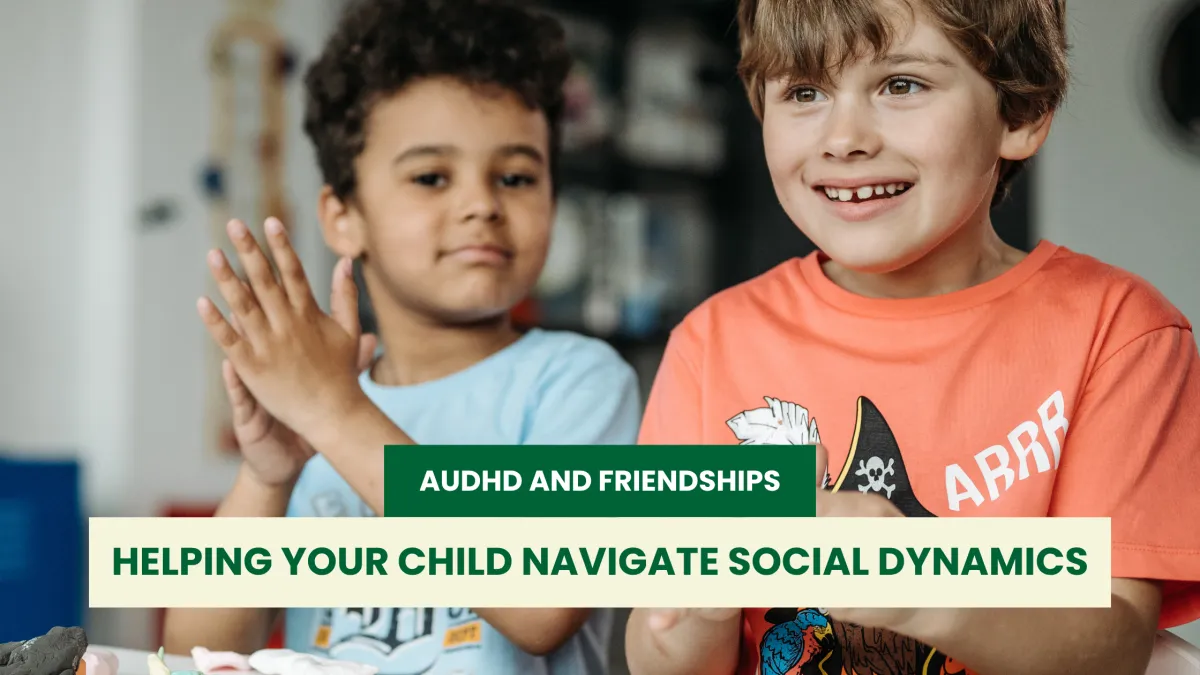
AuDHD and Friendships
"My child wants friends—but doesn’t know how to make or keep them."
"They keep getting left out, and they can’t tell me why."
For many children and teens with AuDHD (autism + ADHD), friendship is a deeply desired but incredibly complicated experience. They want connection—but struggle with the social, sensory, and emotional demands that friendships often require.
In this article, we’ll explore:
Why social skills can be harder for kids with AuDHD
What friendship actually looks like for neurodivergent youth
How to recognize when your child is being excluded or misunderstood
Strategies to support authentic, low-pressure social connection
Why “just be social” doesn’t work—and what to do instead
Why Social Interaction Can Be So Draining
Children with AuDHD may have difficulty with:
Reading social cues
Managing sensory overload in group settings
Coping with rejection sensitivity
Interpreting sarcasm, body language, or tone
Shifting attention between topics in conversation
These challenges don’t mean they don’t care about friendship. In fact, many are deeply empathetic and crave connection. But when every interaction requires conscious effort, socializing becomes exhausting.
Neurodivergent kids often spend so much energy trying to “fit in” that they mask their true selves—leading to anxiety, burnout, and social confusion.
What Friendship Looks Like for AuDHD Kids
Forget the birthday party circuit or constant playdates. For many AuDHD kids, real friendship looks more like:
Parallel play or shared space without constant talking
Deep one-on-one connections with like-minded peers
Online friendships built around shared interests
Intermittent socializing balanced with lots of alone time
It’s not about quantity. It’s about safety, comfort, and mutual understanding.
Subtle Signs of Social Struggle
Many kids can’t articulate that they’re being left out. Instead, you might see:
Increased irritability after school
Sudden disinterest in former friends
Obsession with a single friend or classmate
Imitating others in an exaggerated way
Saying "I don't have any friends" but then refusing social invites
These aren’t contradictions—they’re signals of confusion, pain, or misattunement.
How Parents Can Support Healthy Social Growth
1. Follow Their Lead
Don’t force friendships that don’t feel right to your child. Instead, ask:
"Who do you feel safe around?"
"What kind of person do you like being with?"
Let them define friendship in their own terms.
2. Facilitate Interest-Based Social Opportunities
Look for:
LEGO clubs, coding meetups, nature groups
Online communities for Minecraft, Pokémon, anime, etc.
Classes or groups led by neurodivergent adults
Shared interests help take the pressure off small talk and create natural bridges.
3. Coach Without Controlling
Use social stories or role-plays to prep for interactions:
"What do you do if someone says no?"
"How can you tell someone might need space?"
Practice scripts for setting boundaries and expressing interest.
4. Create a Low-Pressure Social Zone at Home
Sometimes just having a quiet, safe space for a friend to visit can help your child feel in control. Avoid overwhelming social gatherings.
5. Validate Their Experience
Don’t downplay or dismiss friendship struggles. Reflect what you hear:
"It makes sense that you're frustrated."
"It's hard when people don’t see the real you."
Validation builds trust—and makes your child more likely to open up over time.
When to Seek Extra Support
If your child is consistently isolated, afraid of peers, or showing signs of deep social anxiety, consider:
Social skills groups led by therapists who understand neurodivergence
1:1 therapy to build confidence and reduce masking
Helping them connect with other neurodivergent youth
The goal isn’t to make them “more social.” It’s to help them feel safe enough to be themselves—with the right people.
Final Thoughts: Friendship Isn’t One Size Fits All
There’s no single right way to be a friend—and no one “normal” way to build relationships. For AuDHD kids, authentic connection happens when we stop trying to fix them and start creating space for them.
Let them lead. Meet them with curiosity. And help them find their people—not just fit into the crowd.
References
American Psychiatric Association. (2022). Diagnostic and statistical manual of mental disorders (5th ed., text rev.; DSM-5-TR). https://doi.org/10.1176/appi.books.9780890425787
Morrison, K. E., DeBrabander, K. M., Jones, D. R., Faso, D. J., Ackerman, R. A., & Sasson, N. J. (2020). Outcomes of real-world social interaction for autistic adults paired with autistic compared to non-autistic partners. Autism, 24(5), 1067–1080. https://doi.org/10.1177/1362361320903126
Miller, K., Rees, J., & Pearson, A. (2021). Autism and masking: How and why children with autism camouflage at school. Autism, 25(2), 465–478. https://doi.org/10.1177/1362361320963679
